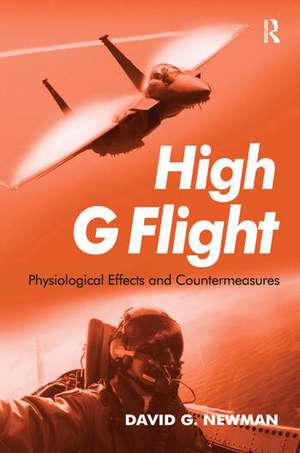High G Flight: Physiological Effects and Countermeasures
Autor David Newmanen Limba Engleză Hardback – 6 mai 2015
Preț: 555.87 lei
Preț vechi: 803.25 lei
-31% Nou
Puncte Express: 834
Preț estimativ în valută:
106.36€ • 111.35$ • 88.01£
106.36€ • 111.35$ • 88.01£
Carte tipărită la comandă
Livrare economică 07-21 aprilie
Preluare comenzi: 021 569.72.76
Specificații
ISBN-13: 9781472414571
ISBN-10: 1472414578
Pagini: 272
Dimensiuni: 156 x 234 x 22 mm
Greutate: 0.64 kg
Ediția:1
Editura: CRC Press
Colecția Routledge
ISBN-10: 1472414578
Pagini: 272
Dimensiuni: 156 x 234 x 22 mm
Greutate: 0.64 kg
Ediția:1
Editura: CRC Press
Colecția Routledge
Public țintă
Professional Practice & DevelopmentNotă biografică
Associate Professor David G. Newman is a consultant in aviation medicine and Head of the Aviation Medicine Unit in the School of Public Health and Preventive Medicine at Monash University in Melbourne, Australia. His 13 years as an aviation medicine specialist in the Royal Australian Air Force, in both Australia and on exchange in the UK, include three years in support of tactical fighter operations and two years as Chief Instructor at the RAAF Institute of Aviation Medicine, where he was responsible for the training of all Australian Defence Force aircrew and medical officers. He holds a medical degree from Monash University, a Diploma in Aviation Medicine from the Royal College of Physicians of London, an MBA from Deakin University and a PhD from the University of Newcastle. He is also a pilot, with flying experience in several military fast jets including the F/A-18 Hornet and the Harrier. He has won numerous awards for his research into aerospace biomechanics and high G physiology, including the Aerospace Medical Association’s Arnold D. Tuttle award in 2000, the Buchanon-Barbour Award from the Royal Aeronautical Society in 2000, and the John Paul Stapp Award from the Aerospace Medical Association in 2014.
Recenzii
’This is the book we have all been waiting for. Dr Newman has skilfully provided a unified understanding of the current state of knowledge on human exposure to high G forces. Clearly written, the reader is taken from basic physics, through the mechanics of flight exposure, to current methods of G protection. Highly recommended.’ Michael Bagshaw, King’s College London and Cranfield University, UK
Cuprins
List of Figures, Foreword by Lieutenant General (Dr) Thomas W. Travis, Preface, Acknowledgements, List of Abbreviations, Part I: Mechanics of G, Part II: Physiology of G, Part III: Tolerance and Adaptation, Part IV: Countermeasures, References, Index
Descriere
Pilots of military fast jets, civilian aerobatic pilots and astronauts are frequently and repetitively exposed to high G forces, for which the human body is not fundamentally designed. This unique book examines the nature of the high G environment and its physiological effects on the various systems of the human body. It draws together the accumulated knowledge of human exposure to high G, resulting in a definitive volume on its physiological effects and countermeasures.
